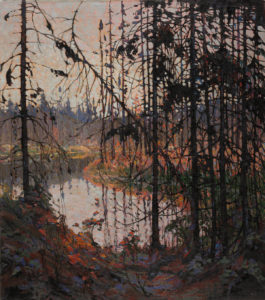A climate activist, mirroring similar incidents in Europe last year, has defaced a painting kept at the National Gallery of Canada in Ottawa. Kaleb Suedfeld, age 28, is a member of the Canadian environmentalist group On2Ottawa, which uses “nonviolent civil disobedience to get urgent government action on the climate crisis”. The organization uploaded a video on Facebook, showing Suedfeld splattering pink paint onto the surface of a canvas, smearing it on, wiping his hand on his pants, and then applying glue to his hand to adhere himself to the floor. He then read a speech, commenting how the anger many will feel about his demonstration is comparable to the anger many feel about government inaction on the climate crisis. Suedfeld placed particular emphasis on the recent wildfires that have ravaged Canada this year, which have burned 37 million acres of land, emitted over 300 million tons of carbon equivalents, displaced tens of thousands, and killed four firefighters. He called for forming a Canadian national firefighting service to deal with the wildfires more effectively. This would also prevent regional authorities from stripping fire departments of resources for cost-cutting purposes. Suedfeld was arrested and charged with criminal mischief.
The work Suedfeld used in his demonstration was Northern River, a 1915 landscape painting created by the great Canadian artist Tom Thomson. Thomson was incredibly influential on his contemporaries and later generations of Canadian artists. He is often associated with the Canadian school known as the Group of Seven, consisting of landscape painters like J.E.H. McDonald, Franklin Carmichael, Frank Johnston, and others, who sought to develop a distinctly Canadian form of landscape art through direct contact with nature. Thomson was not officially part of the Group of Seven since he accidentally drowned and died in 1917, three years before the group’s formation. Given Thomson’s association with Canadian landscape painting, the protestor’s choice of painting was likely not a coincidence. Northern River has a layer of protective glass over it. Therefore, the work was protected and the paint could easily be washed off.
While it is fortunate that Northern River was unharmed during the demonstration, it may be easy to overlook what the protest was about. For many, this was one of North America’s first museum demonstrations of note. Suedfeld gave a speech in English, all of which his colleagues filmed and posted online. With the climate change demonstrations in Europe that started last year, I think many people in the US and the broader English-speaking world were more ready to dismiss them since all we saw were soiled Van Gogh and Monet paintings alongside young people gluing their hands to the wall. Though a similar incident took place in April at the National Gallery of Art in Washington, for me this was the first incident that seemed closer to home, since not only was there a pre-prepared speech but it was in my own language. It struck me harder than the other incidents. I had seen all the others, but this was the first time when I actually heard them.
Suedfeld also specifically mentioned the recent wildfires that have devastated Canada this year, something that many across North America felt the effects of. Banks of smoke blown south placed a good chunk of the Eastern United States in an orange haze for much of June. As some have predicted, studies from the University of Pennsylvania indicate that this new strategy among climate activists has led to decreased support for addressing climate change. On2Ottawa released a statement saying that another demonstration would take place in the near future.

